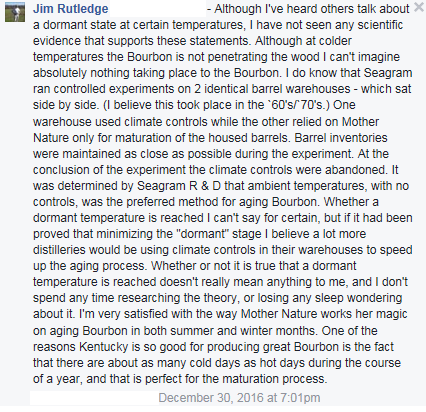Wintertime, and the Whiskey is Lazy?
We have stepped with both feet into Winter now that it is January. Starting today, the Bluegrass will dip beneath 32°F and stay there for about 5 days. What is happening inside all of those barrels camping out in their metal (or brick) tents? You can probably take any tour offered on the Kentucky Bourbon Trail™ and hear well-meaning tour guide after well-meaning tour guide explain the same story--that the whiskey spent all of Summer in an expanded state, playing in the wood outside of the charred walls of home (or even evaporating away into that great tumbler in the sky), then, after growing tired from all of that play, retreating back inside to get tucked into its American White Oak bed by Mother Winter.Is it true, as the Van Winkles might say, that whiskey in the Winter is "asleep . . . in the wood"? Yes and no.I am personally familiar with the story, and I have always heard that 45°F is the magic point at which whiskey decides to take its slumber. I never gave that hard number much thought as so many variables can affect the volatility of a liquid. Temperature, humidity and pressure are just a few. Physics teachers will tell you that things expand as they are heated. As temperature drops, those same things contract. Whiskey, therefore, expands into the barrel staves, passing through the char layer in the hotter months, and contracts back through the char layer into the barrel in the colder months. I am sure, scientifically, there is a way that, if you have a few constants like chemical composition, humidity or pressure, you can calculate the exact temperature at which a whiskey will no longer pass through the char layer. Let's save that for someone's thesis.Recently, a member of our group that is in the supply-side of the "industry" was told by an unnamed American whiskey maker that the magic point was 60°F. To me, a 60°F magic point is just too high. If that was the case, the whiskey at Hillrock Estate in Ancram, New York or WhistlePig in Shoreham, Vermont would spend most of the year not "aging." A large portion of this group member's business involves Scotch, and his memories of the weather in Scotland immediately set off alarm bells at such a high magic point. He asked a few experts in the Scotch industry for their thoughts. One shot back this quick quip: "For reference the average warehouse temp in Scotland is 54°F so let's hope global warming kicks in soon so we can start making whisky here at some point." And another had a little more to say:
There is certainly some truth in this statement; in cooler conditions, there is much less wood extraction, higher temperatures tend to drive flavour out of the wood. This is one of the primary reasons that most US whiskies are bottled at much younger ages than Scotch malt.
It is, not, however, true to say that the whisky lies 'dormant'; there are degrees of oxidative ageing, which while not driving wood-derived flavours, will result in the production of many molecules giving fragrance and complexity, such as di-ethyl acetal, which is responsible for some of the herbal/minty notes in whisky.
If conditions are also damp, this helps encourage oxidative ageing. And for what this is worth, I believe that Yoichi is my favourite Japanese whisky because in Hokkaido, where the stock is aged, conditions are cooler and damper than in Honshu, the main island of Japan, hence Yoichi's Scotch-like complexity.
But those comments are only good for Scotland and Japan, right? What about in Kentucky where so much of the world's bourbon spends its days?Reid Mitenbuler, in his book Bourbon Empire: The Past and Future of America's Whiskey, devotes a page to information provided by Brown-Forman's Master Distiller Chris Morris that might support the argument that whiskey goes "dormant" in the colder months. Chris Morris noted, as Reid put it in "very general terms," that some barrels in the Brown-Forman warehouses have temperature probes that will turn on a heating system once the temperature inside the barrels dips to, get this, 60°F!¹ At the same time, Chris Morris says, "Hot or cold, you have material from the wood being absorbed by the spirit."²Jim Rutledge recently dropped into a Four Roses tribute group on Facebook to matter-of-factly give his thoughts on, among other things, the idea of whether whiskey will go "dormant" during colder months. Here is what Jim thinks: Maker's Mark seems to agree with Chris Morris that, hot or cold, the whiskey will pull some flavor from the wood. Just look at Maker's 46, which is aged in barrels containing suspended French oak staves toasted to the specifications of Recipe No. 46 and, until recently, was only aged in the cooler months. Now, Maker's Mark is building a limestone cellar to age Maker's 46 in a cooler environment year round.So, "dormant" or not, whiskey does not stop evolving. You cannot flip a switch and turn chemistry on or off.What does happen to whiskey during the colder months? You'd be surprised, but that is a tale for another day. ¹Mitenbuler, Reid. Bourbon Empire: The Past and Future of America's Whiskey. New York, NY: Penguin Books; 2015, p. 151.²Id.
Maker's Mark seems to agree with Chris Morris that, hot or cold, the whiskey will pull some flavor from the wood. Just look at Maker's 46, which is aged in barrels containing suspended French oak staves toasted to the specifications of Recipe No. 46 and, until recently, was only aged in the cooler months. Now, Maker's Mark is building a limestone cellar to age Maker's 46 in a cooler environment year round.So, "dormant" or not, whiskey does not stop evolving. You cannot flip a switch and turn chemistry on or off.What does happen to whiskey during the colder months? You'd be surprised, but that is a tale for another day. ¹Mitenbuler, Reid. Bourbon Empire: The Past and Future of America's Whiskey. New York, NY: Penguin Books; 2015, p. 151.²Id.
